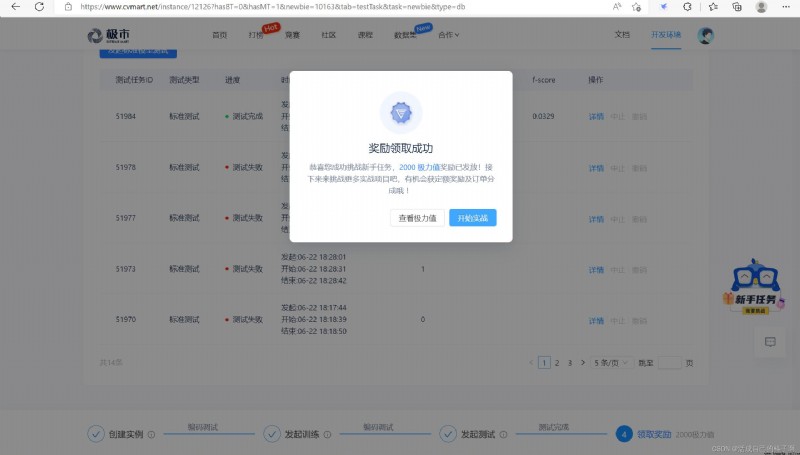目錄
時間:2022.6.23
極市的新人任務——安全帽識別通過簡單的賽題帶我們更好的熟悉了極市比賽、項目的打榜流程。
如果你也是深度學習愛好者,也不妨短暫停留看看!!!
1.開發環境選擇
2.配置yolov5環境
3.編寫代碼
4.模型訓練
5.模型測試
6.領取獎勵
沒有誰的成功是一步而就的,你需要花費比別人更多的時間,更多的精力,更多的熱愛。
極市開發者平台-計算機視覺算法開發落地平台 (cvmart.net) https://www.cvmart.net/
https://www.cvmart.net/
說明文檔:(裡面有一個yolov5教程)
極市開發者平台-計算機視覺算法開發落地平台 (cvmart.net) https://www.cvmart.net/document
https://www.cvmart.net/document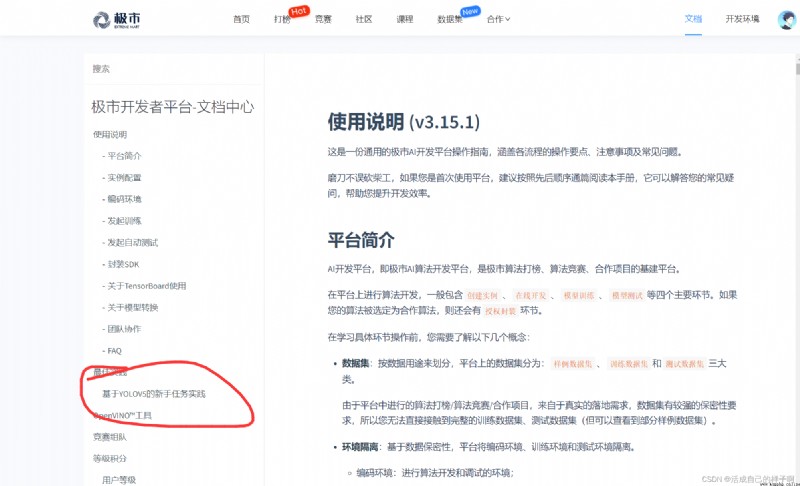
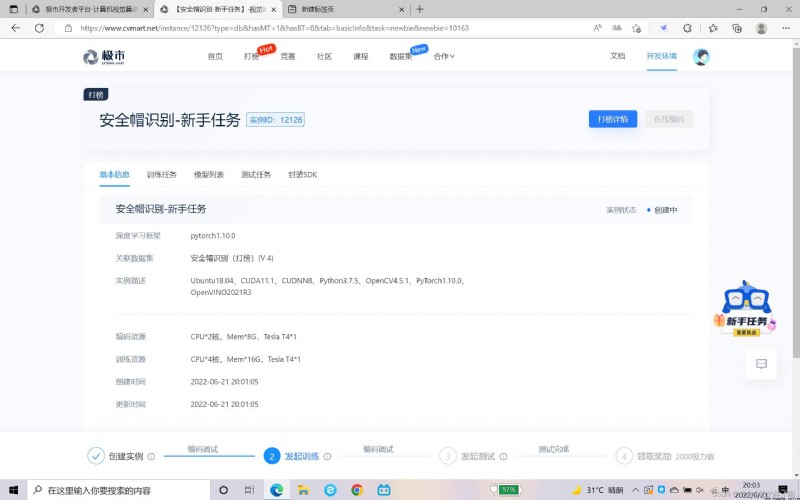
我選擇的是pytorch1.10.0,實例是一個烏班圖系統,CUDA、OPENCV均自帶好了,顯卡是一張Tesla的顯卡,顯存大概15G。
Linux基礎命令:(大神這裡直接跳過吧~)//可能會用到
回到根目錄:cd /
回到父級目錄:cd ..
進入目錄:cd XXX
列出當前目錄下面的所有文件:ls
編輯文件:vim XXX
--保存並退出::wq
--進入編譯模式:i
--退出編譯模式:【esc】
清屏:clear
軟連接:ln -s 目標文件或文件夾 軟連接名字
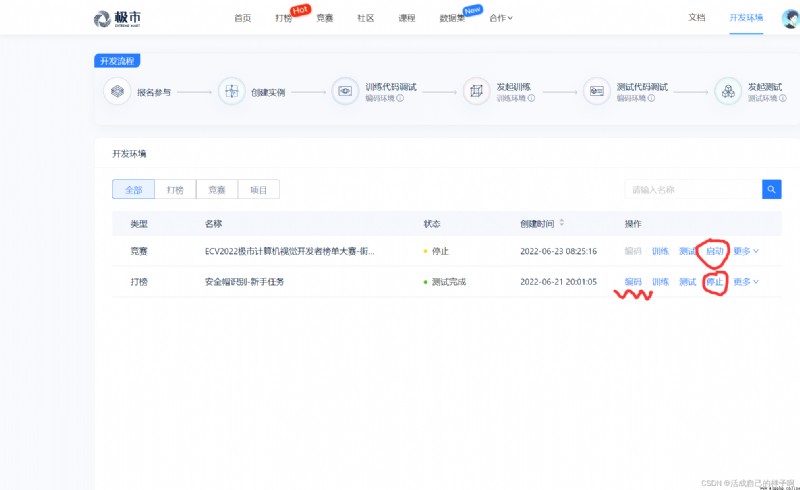
編碼注意事項:
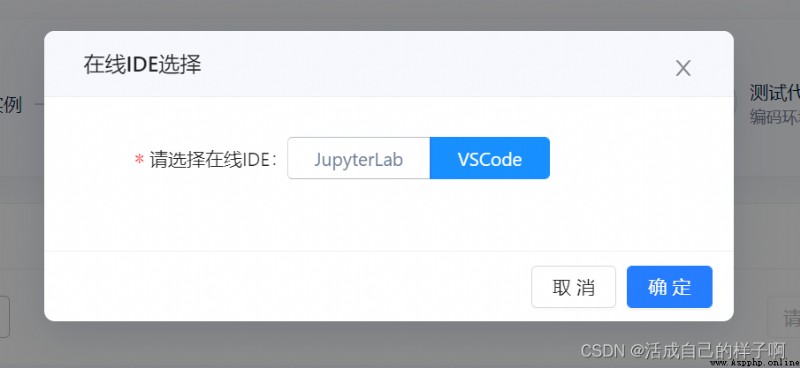
這裡我選擇的是VSCode編譯器,他類似於咱的PyCharm,左邊那個就是咱的老朋友Jupyter。
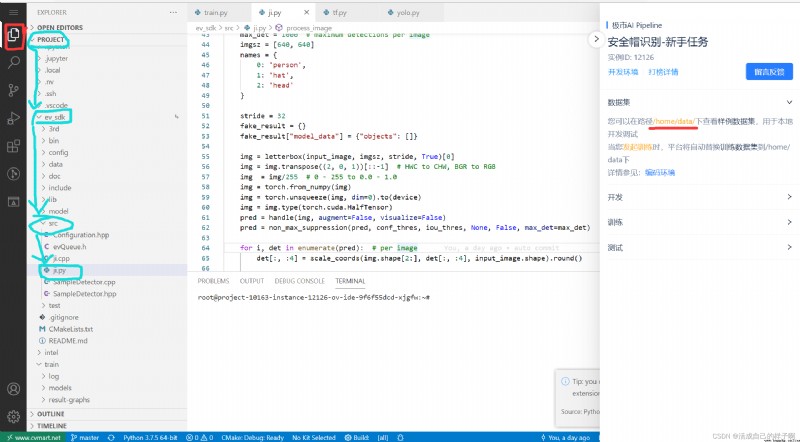
點擊左邊的畫紅圈的那個,那個是文件樹列表,藍色的是測試的時候要建立一個ji.py文件,右邊紅色劃線的時數據集存放的地方(我們只能看到樣例數據集,看不到全部數據集)。
在編寫代碼之前,我先給大家看一下咱的數據集長啥樣~~~
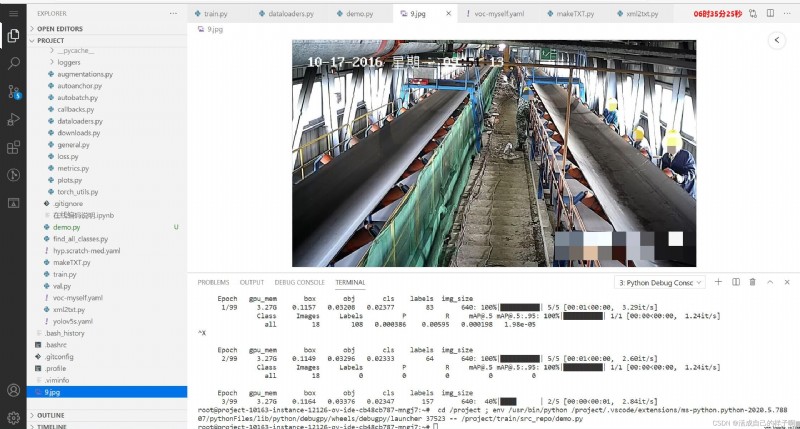
(指標都是0是因為數據集太少+學習率太高~~~~)
注:通過前面寫的linux指令就能把他弄出來啦~~~
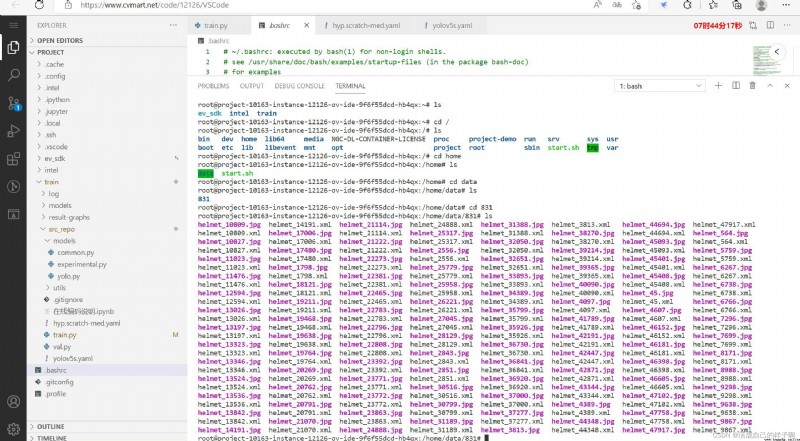
可以看到極市的數據集都是標注好的VOC格式。
下一步,我們轉移咱的yolov5代碼,目前有兩種方法(可能還有更多,我還沒發現!!!)
1.把自己寫好的代碼復制上去——CV呗~(這種方法雖然笨,但是可以把自己改完的模型、代碼上傳上去)
2.打開終端:(Ctrl + J)
cd /project/train/src_repo
git clone https://github.com/ultralytics/yolov5 # clone
cd yolov5
pip install -r requirements.txt # install這一步就和咱平時寫代碼一樣。
附上一個我使用yolov5做項目的文章吧,這裡就不再細細展開啦!!抱歉!抱歉!具體使用方法詳見:
(132條消息) 【python 目標檢測】基於深度學習的道路破損檢測|yolov5|VOC_活成自己的樣子啊的博客-CSDN博客_路面破損數據集 https://blog.csdn.net/m0_61139217/article/details/124182727?spm=1001.2014.3001.5501
https://blog.csdn.net/m0_61139217/article/details/124182727?spm=1001.2014.3001.5501
調試:F5 【不論是訓練還是測試,都要先在本地調試,本地也有一張15G的顯卡的,可以用於調試】
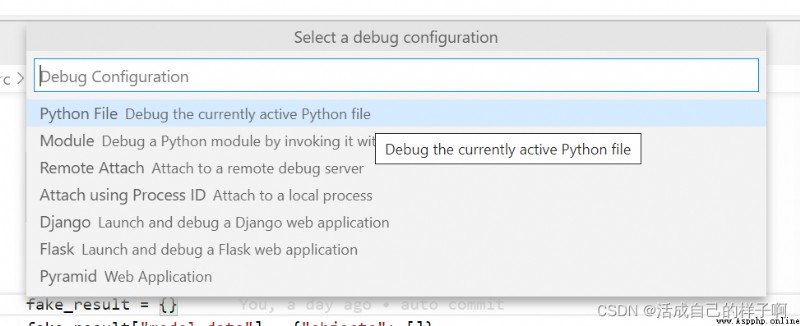
這裡我是點擊的第一個。
配置、轉換數據集,為了放入咱的模型訓練,我們需要把VOC轉成YOLO格式的數據集,如圖所示是我的數據集存放路徑樹:(和我做yolov5的時候基本一樣)
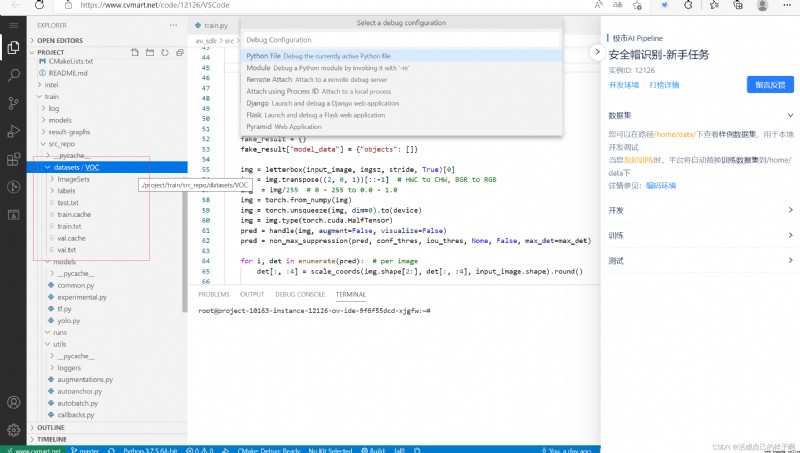
這裡給出變化後的2個制作數據集的代碼:(注意位置!!!)(這裡的相對路徑寫法一定要注意!!!)
/project/train/src_repo/makeTXT.py
"""生成Main裡面的4個txt文件,對應每一個圖片名稱"""
import os
import random
def makeTXT():
traintest_percent = 0.9 # 測試集的比例(1-traintest_percent)
train_percent = 0.8 # 訓練集和測試集的比例(訓練集的占比)
base_path = '/home/data' # xml
base_path = os.path.join(base_path, os.listdir(base_path)[0])
txtsavepath = 'train/src_repo/datasets/VOC/ImageSets/Main' # 訓練集、驗證集、測試集的路徑
total_xml = []
for each_path in os.listdir(base_path):
xmlfilepath = each_path.endswith('.xml')
if xmlfilepath:
total_xml.append(each_path)
num = len(total_xml)
list = range(num) # 【0, num - 1】
tv = int(num * traintest_percent) # 驗證集和訓練集的數量
tr = int(tv * train_percent) # 訓練集數量
# sample(list, k)返回一個長度為k新列表,新列表存放list所產生k個隨機唯一的元素
trainval = random.sample(list, tv)
train = random.sample(trainval, tr)
ftrainval = open(txtsavepath + '/trainval.txt', 'w')
ftest = open(txtsavepath + '/test.txt', 'w')
ftrain = open(txtsavepath + '/train.txt', 'w')
fval = open(txtsavepath + '/val.txt', 'w')
for i in list:
# [:-4]切掉後4位(.xml)
name = total_xml[i][:-4] + '\n'
if i in trainval:
ftrainval.write(name)
if i in train:
ftrain.write(name)
else:
fval.write(name)
else:
ftest.write(name)
ftrainval.close()
ftrain.close()
fval.close()
ftest.close()/project/train/src_repo/xml2txt.py
import xml.etree.ElementTree as ET
import pickle
import os
from os import listdir, getcwd
from os.path import join
# sets設置的就是
sets = ['train', 'val', 'test']
# 類別
classes = ['hat', 'person', 'head'] # 尋找類別(這裡寫自己標注的類別就行)
# 轉換成yolo格式的標注【類別, x代表標注中心橫坐標在圖像中的比例,y代表標注中心縱坐標在圖像中的比例,w表示標注框寬占比,h表示標注框高占比】
def convert(size, box):
dw = 1. / size[0]
dh = 1. / size[1]
x = (box[0] + box[1]) / 2.0 - 1
y = (box[2] + box[3]) / 2.0 - 1
w = box[1] - box[0]
h = box[3] - box[2]
x = x * dw
w = w * dw
y = y * dh
h = h * dh
return (x, y, w, h)
def convert_annotation(image_id):
in_file = open('/home/data/831/%s.xml' % image_id, encoding='utf8')
out_file = open('train/src_repo/datasets/VOC/labels/%s.txt' % image_id, 'w')
tree = ET.parse(in_file)
root = tree.getroot()
size = root.find('size')
w = int(size.find('width').text)
h = int(size.find('height').text)
for obj in root.iter('object'):
cls = obj.find('name').text
if cls not in classes:
continue
cls_id = classes.index(cls)
xmlbox = obj.find('bndbox')
# b是2個坐標的4個值
b = (float(xmlbox.find('xmin').text), float(xmlbox.find('xmax').text), float(xmlbox.find('ymin').text),
float(xmlbox.find('ymax').text))
bb = convert((w, h), b)
# 【類別, x代表標注中心橫坐標在圖像中的比例,y代表標注中心縱坐標在圖像中的比例,w表示標注框寬占比,h表示標注框高占比】
out_file.write(str(cls_id) + " " + " ".join([str(a) for a in bb]) + '\n')
def runs():
wd = r'train/src_repo/datasets/VOC'
# sets:train、val、test
for image_set in sets:
# 創建labels
if not os.path.exists(wd + '/labels/'):
os.makedirs(wd + '/labels/')
image_ids = open('train/src_repo/datasets/VOC/ImageSets/Main/%s.txt' % image_set).read().strip().split()
list_file = open('train/src_repo/datasets/VOC/%s.txt' % image_set, 'w')
# 對每一張進行操作
for image_id in image_ids:
list_file.write('/home/data/831/%s.jpg\n' % image_id) # 寫入每一個圖片的路徑
convert_annotation(image_id)
list_file.close()/project/train/src_repo/train.py (這個是在原有train.py基礎上改變過來的!!!直接CV即可)
修改:
---1---命令行參數默認值直接設置好了(所設置的文件路徑也是需要放置的路徑,比如hyp、data、model的yaml文件)
---2---其次是把上面的兩個數據集制作函數一起加入到train.py裡面了,這樣就不用寫.sh文件來啟動命令了,對linux新手甚是友好!
---3---project保存路徑改為:/project/train/tensorboard (為了方便極市打開tensorboard)
---4---模型保存改為:torch.save(ckpt, r'/project/train/models/' + f'epoch{epoch}.pt')
import argparse
import math
import os
import random
import sys
import time
from copy import deepcopy
from datetime import datetime
from pathlib import Path
import numpy as np
import torch
import torch.distributed as dist
import torch.nn as nn
import yaml
from torch.nn.parallel import DistributedDataParallel as DDP
from torch.optim import SGD, Adam, AdamW, lr_scheduler
from tqdm import tqdm
FILE = Path(__file__).resolve()
ROOT = FILE.parents[0] # YOLOv5 root directory
if str(ROOT) not in sys.path:
sys.path.append(str(ROOT)) # add ROOT to PATH
ROOT = Path(os.path.relpath(ROOT, Path.cwd())) # relative
import val # for end-of-epoch mAP
from models.experimental import attempt_load
from models.yolo import Model
from utils.autoanchor import check_anchors
from utils.autobatch import check_train_batch_size
from utils.callbacks import Callbacks
from utils.dataloaders import create_dataloader
from utils.downloads import attempt_download
from utils.general import (LOGGER, check_amp, check_dataset, check_file, check_git_status, check_img_size,
check_requirements, check_suffix, check_version, check_yaml, colorstr, get_latest_run,
increment_path, init_seeds, intersect_dicts, labels_to_class_weights,
labels_to_image_weights, methods, one_cycle, print_args, print_mutation, strip_optimizer)
from utils.loggers import Loggers
from utils.loggers.wandb.wandb_utils import check_wandb_resume
from utils.loss import ComputeLoss
from utils.metrics import fitness
from utils.plots import plot_evolve, plot_labels
from utils.torch_utils import EarlyStopping, ModelEMA, de_parallel, select_device, torch_distributed_zero_first
LOCAL_RANK = int(os.getenv('LOCAL_RANK', -1)) # https://pytorch.org/docs/stable/elastic/run.html
RANK = int(os.getenv('RANK', -1))
WORLD_SIZE = int(os.getenv('WORLD_SIZE', 1))
def train(hyp, opt, device, callbacks): # hyp is path/to/hyp.yaml or hyp dictionary
save_dir, epochs, batch_size, weights, single_cls, evolve, data, cfg, resume, noval, nosave, workers, freeze = \
Path(opt.save_dir), opt.epochs, opt.batch_size, opt.weights, opt.single_cls, opt.evolve, opt.data, opt.cfg, \
opt.resume, opt.noval, opt.nosave, opt.workers, opt.freeze
callbacks.run('on_pretrain_routine_start')
# Directories
w = save_dir / 'weights' # weights dir
(w.parent if evolve else w).mkdir(parents=True, exist_ok=True) # make dir
last, best = w / 'last.pt', w / 'best.pt'
# Hyperparameters
if isinstance(hyp, str):
with open(hyp, errors='ignore') as f:
hyp = yaml.safe_load(f) # load hyps dict
LOGGER.info(colorstr('hyperparameters: ') + ', '.join(f'{k}={v}' for k, v in hyp.items()))
# Save run settings
if not evolve:
with open(save_dir / 'hyp.yaml', 'w') as f:
yaml.safe_dump(hyp, f, sort_keys=False)
with open(save_dir / 'opt.yaml', 'w') as f:
yaml.safe_dump(vars(opt), f, sort_keys=False)
# Loggers
data_dict = None
if RANK in {-1, 0}:
loggers = Loggers(save_dir, weights, opt, hyp, LOGGER) # loggers instance
if loggers.wandb:
data_dict = loggers.wandb.data_dict
if resume:
weights, epochs, hyp, batch_size = opt.weights, opt.epochs, opt.hyp, opt.batch_size
# Register actions
for k in methods(loggers):
callbacks.register_action(k, callback=getattr(loggers, k))
# Config
plots = not evolve and not opt.noplots # create plots
cuda = device.type != 'cpu'
init_seeds(1 + RANK)
with torch_distributed_zero_first(LOCAL_RANK):
data_dict = data_dict or check_dataset(data) # check if None
train_path, val_path = data_dict['train'], data_dict['val']
nc = 1 if single_cls else int(data_dict['nc']) # number of classes
names = ['item'] if single_cls and len(data_dict['names']) != 1 else data_dict['names'] # class names
assert len(names) == nc, f'{len(names)} names found for nc={nc} dataset in {data}' # check
is_coco = isinstance(val_path, str) and val_path.endswith('coco/val2017.txt') # COCO dataset
# Model
check_suffix(weights, '.pt') # check weights
pretrained = weights.endswith('.pt')
if pretrained:
with torch_distributed_zero_first(LOCAL_RANK):
weights = attempt_download(weights) # download if not found locally
ckpt = torch.load(weights, map_location='cpu') # load checkpoint to CPU to avoid CUDA memory leak
model = Model(cfg or ckpt['model'].yaml, ch=3, nc=nc, anchors=hyp.get('anchors')).to(device) # create
exclude = ['anchor'] if (cfg or hyp.get('anchors')) and not resume else [] # exclude keys
csd = ckpt['model'].float().state_dict() # checkpoint state_dict as FP32
csd = intersect_dicts(csd, model.state_dict(), exclude=exclude) # intersect
model.load_state_dict(csd, strict=False) # load
LOGGER.info(f'Transferred {len(csd)}/{len(model.state_dict())} items from {weights}') # report
else:
model = Model(cfg, ch=3, nc=nc, anchors=hyp.get('anchors')).to(device) # create
amp = check_amp(model) # check AMP
# Freeze
freeze = [f'model.{x}.' for x in (freeze if len(freeze) > 1 else range(freeze[0]))] # layers to freeze
for k, v in model.named_parameters():
v.requires_grad = True # train all layers
if any(x in k for x in freeze):
LOGGER.info(f'freezing {k}')
v.requires_grad = False
# Image size
gs = max(int(model.stride.max()), 32) # grid size (max stride)
imgsz = check_img_size(opt.imgsz, gs, floor=gs * 2) # verify imgsz is gs-multiple
# Batch size
if RANK == -1 and batch_size == -1: # single-GPU only, estimate best batch size
batch_size = check_train_batch_size(model, imgsz, amp)
loggers.on_params_update({"batch_size": batch_size})
# Optimizer
nbs = 64 # nominal batch size
accumulate = max(round(nbs / batch_size), 1) # accumulate loss before optimizing
hyp['weight_decay'] *= batch_size * accumulate / nbs # scale weight_decay
LOGGER.info(f"Scaled weight_decay = {hyp['weight_decay']}")
g = [], [], [] # optimizer parameter groups
bn = tuple(v for k, v in nn.__dict__.items() if 'Norm' in k) # normalization layers, i.e. BatchNorm2d()
for v in model.modules():
if hasattr(v, 'bias') and isinstance(v.bias, nn.Parameter): # bias
g[2].append(v.bias)
if isinstance(v, bn): # weight (no decay)
g[1].append(v.weight)
elif hasattr(v, 'weight') and isinstance(v.weight, nn.Parameter): # weight (with decay)
g[0].append(v.weight)
if opt.optimizer == 'Adam':
optimizer = Adam(g[2], lr=hyp['lr0'], betas=(hyp['momentum'], 0.999)) # adjust beta1 to momentum
elif opt.optimizer == 'AdamW':
optimizer = AdamW(g[2], lr=hyp['lr0'], betas=(hyp['momentum'], 0.999)) # adjust beta1 to momentum
else:
optimizer = SGD(g[2], lr=hyp['lr0'], momentum=hyp['momentum'], nesterov=True)
optimizer.add_param_group({'params': g[0], 'weight_decay': hyp['weight_decay']}) # add g0 with weight_decay
optimizer.add_param_group({'params': g[1]}) # add g1 (BatchNorm2d weights)
LOGGER.info(f"{colorstr('optimizer:')} {type(optimizer).__name__} with parameter groups "
f"{len(g[1])} weight (no decay), {len(g[0])} weight, {len(g[2])} bias")
del g
# Scheduler
if opt.cos_lr:
lf = one_cycle(1, hyp['lrf'], epochs) # cosine 1->hyp['lrf']
else:
lf = lambda x: (1 - x / epochs) * (1.0 - hyp['lrf']) + hyp['lrf'] # linear
scheduler = lr_scheduler.LambdaLR(optimizer, lr_lambda=lf) # plot_lr_scheduler(optimizer, scheduler, epochs)
# EMA
ema = ModelEMA(model) if RANK in {-1, 0} else None
# Resume
start_epoch, best_fitness = 0, 0.0
if pretrained:
# Optimizer
if ckpt['optimizer'] is not None:
optimizer.load_state_dict(ckpt['optimizer'])
best_fitness = ckpt['best_fitness']
# EMA
if ema and ckpt.get('ema'):
ema.ema.load_state_dict(ckpt['ema'].float().state_dict())
ema.updates = ckpt['updates']
# Epochs
start_epoch = ckpt['epoch'] + 1
if resume:
assert start_epoch > 0, f'{weights} training to {epochs} epochs is finished, nothing to resume.'
if epochs < start_epoch:
LOGGER.info(f"{weights} has been trained for {ckpt['epoch']} epochs. Fine-tuning for {epochs} more epochs.")
epochs += ckpt['epoch'] # finetune additional epochs
del ckpt, csd
# DP mode
if cuda and RANK == -1 and torch.cuda.device_count() > 1:
LOGGER.warning('WARNING: DP not recommended, use torch.distributed.run for best DDP Multi-GPU results.\n'
'See Multi-GPU Tutorial at https://github.com/ultralytics/yolov5/issues/475 to get started.')
model = torch.nn.DataParallel(model)
# SyncBatchNorm
if opt.sync_bn and cuda and RANK != -1:
model = torch.nn.SyncBatchNorm.convert_sync_batchnorm(model).to(device)
LOGGER.info('Using SyncBatchNorm()')
# Trainloader
train_loader, dataset = create_dataloader(train_path,
imgsz,
batch_size // WORLD_SIZE,
gs,
single_cls,
hyp=hyp,
augment=True,
cache=None if opt.cache == 'val' else opt.cache,
rect=opt.rect,
rank=LOCAL_RANK,
workers=workers,
image_weights=opt.image_weights,
quad=opt.quad,
prefix=colorstr('train: '),
shuffle=True)
mlc = int(np.concatenate(dataset.labels, 0)[:, 0].max()) # max label class
nb = len(train_loader) # number of batches
assert mlc < nc, f'Label class {mlc} exceeds nc={nc} in {data}. Possible class labels are 0-{nc - 1}'
# Process 0
if RANK in {-1, 0}:
val_loader = create_dataloader(val_path,
imgsz,
batch_size // WORLD_SIZE * 2,
gs,
single_cls,
hyp=hyp,
cache=None if noval else opt.cache,
rect=True,
rank=-1,
workers=workers * 2,
pad=0.5,
prefix=colorstr('val: '))[0]
if not resume:
labels = np.concatenate(dataset.labels, 0)
# c = torch.tensor(labels[:, 0]) # classes
# cf = torch.bincount(c.long(), minlength=nc) + 1. # frequency
# model._initialize_biases(cf.to(device))
if plots:
plot_labels(labels, names, save_dir)
# Anchors
if not opt.noautoanchor:
check_anchors(dataset, model=model, thr=hyp['anchor_t'], imgsz=imgsz)
model.half().float() # pre-reduce anchor precision
callbacks.run('on_pretrain_routine_end')
# DDP mode
if cuda and RANK != -1:
if check_version(torch.__version__, '1.11.0'):
model = DDP(model, device_ids=[LOCAL_RANK], output_device=LOCAL_RANK, static_graph=True)
else:
model = DDP(model, device_ids=[LOCAL_RANK], output_device=LOCAL_RANK)
# Model attributes
nl = de_parallel(model).model[-1].nl # number of detection layers (to scale hyps)
hyp['box'] *= 3 / nl # scale to layers
hyp['cls'] *= nc / 80 * 3 / nl # scale to classes and layers
hyp['obj'] *= (imgsz / 640) ** 2 * 3 / nl # scale to image size and layers
hyp['label_smoothing'] = opt.label_smoothing
model.nc = nc # attach number of classes to model
model.hyp = hyp # attach hyperparameters to model
model.class_weights = labels_to_class_weights(dataset.labels, nc).to(device) * nc # attach class weights
model.names = names
# Start training
t0 = time.time()
nw = max(round(hyp['warmup_epochs'] * nb), 100) # number of warmup iterations, max(3 epochs, 100 iterations)
# nw = min(nw, (epochs - start_epoch) / 2 * nb) # limit warmup to < 1/2 of training
last_opt_step = -1
maps = np.zeros(nc) # mAP per class
results = (0, 0, 0, 0, 0, 0, 0) # P, R, [email protected], [email protected], val_loss(box, obj, cls)
scheduler.last_epoch = start_epoch - 1 # do not move
scaler = torch.cuda.amp.GradScaler(enabled=amp)
stopper = EarlyStopping(patience=opt.patience)
compute_loss = ComputeLoss(model) # init loss class
callbacks.run('on_train_start')
LOGGER.info(f'Image sizes {imgsz} train, {imgsz} val\n'
f'Using {train_loader.num_workers * WORLD_SIZE} dataloader workers\n'
f"Logging results to {colorstr('bold', save_dir)}\n"
f'Starting training for {epochs} epochs...')
for epoch in range(start_epoch, epochs): # epoch ------------------------------------------------------------------
callbacks.run('on_train_epoch_start')
model.train()
# Update image weights (optional, single-GPU only)
if opt.image_weights:
cw = model.class_weights.cpu().numpy() * (1 - maps) ** 2 / nc # class weights
iw = labels_to_image_weights(dataset.labels, nc=nc, class_weights=cw) # image weights
dataset.indices = random.choices(range(dataset.n), weights=iw, k=dataset.n) # rand weighted idx
# Update mosaic border (optional)
# b = int(random.uniform(0.25 * imgsz, 0.75 * imgsz + gs) // gs * gs)
# dataset.mosaic_border = [b - imgsz, -b] # height, width borders
mloss = torch.zeros(3, device=device) # mean losses
if RANK != -1:
train_loader.sampler.set_epoch(epoch)
pbar = enumerate(train_loader)
LOGGER.info(('\n' + '%10s' * 7) % ('Epoch', 'gpu_mem', 'box', 'obj', 'cls', 'labels', 'img_size'))
if RANK in {-1, 0}:
pbar = tqdm(pbar, total=nb, bar_format='{l_bar}{bar:10}{r_bar}{bar:-10b}') # progress bar
optimizer.zero_grad()
for i, (imgs, targets, paths, _) in pbar: # batch -------------------------------------------------------------
callbacks.run('on_train_batch_start')
ni = i + nb * epoch # number integrated batches (since train start)
imgs = imgs.to(device, non_blocking=True).float() / 255 # uint8 to float32, 0-255 to 0.0-1.0
# Warmup
if ni <= nw:
xi = [0, nw] # x interp
# compute_loss.gr = np.interp(ni, xi, [0.0, 1.0]) # iou loss ratio (obj_loss = 1.0 or iou)
accumulate = max(1, np.interp(ni, xi, [1, nbs / batch_size]).round())
for j, x in enumerate(optimizer.param_groups):
# bias lr falls from 0.1 to lr0, all other lrs rise from 0.0 to lr0
x['lr'] = np.interp(ni, xi, [hyp['warmup_bias_lr'] if j == 2 else 0.0, x['initial_lr'] * lf(epoch)])
if 'momentum' in x:
x['momentum'] = np.interp(ni, xi, [hyp['warmup_momentum'], hyp['momentum']])
# Multi-scale
if opt.multi_scale:
sz = random.randrange(imgsz * 0.5, imgsz * 1.5 + gs) // gs * gs # size
sf = sz / max(imgs.shape[2:]) # scale factor
if sf != 1:
ns = [math.ceil(x * sf / gs) * gs for x in imgs.shape[2:]] # new shape (stretched to gs-multiple)
imgs = nn.functional.interpolate(imgs, size=ns, mode='bilinear', align_corners=False)
# Forward
with torch.cuda.amp.autocast(amp):
pred = model(imgs) # forward
loss, loss_items = compute_loss(pred, targets.to(device)) # loss scaled by batch_size
if RANK != -1:
loss *= WORLD_SIZE # gradient averaged between devices in DDP mode
if opt.quad:
loss *= 4.
# Backward
scaler.scale(loss).backward()
# Optimize
if ni - last_opt_step >= accumulate:
scaler.step(optimizer) # optimizer.step
scaler.update()
optimizer.zero_grad()
if ema:
ema.update(model)
last_opt_step = ni
# Log
if RANK in {-1, 0}:
mloss = (mloss * i + loss_items) / (i + 1) # update mean losses
mem = f'{torch.cuda.memory_reserved() / 1E9 if torch.cuda.is_available() else 0:.3g}G' # (GB)
pbar.set_description(('%10s' * 2 + '%10.4g' * 5) %
(f'{epoch}/{epochs - 1}', mem, *mloss, targets.shape[0], imgs.shape[-1]))
callbacks.run('on_train_batch_end', ni, model, imgs, targets, paths, plots)
if callbacks.stop_training:
return
# end batch ------------------------------------------------------------------------------------------------
# Scheduler
lr = [x['lr'] for x in optimizer.param_groups] # for loggers
scheduler.step()
if RANK in {-1, 0}:
# mAP
callbacks.run('on_train_epoch_end', epoch=epoch)
ema.update_attr(model, include=['yaml', 'nc', 'hyp', 'names', 'stride', 'class_weights'])
final_epoch = (epoch + 1 == epochs) or stopper.possible_stop
if not noval or final_epoch: # Calculate mAP
results, maps, _ = val.run(data_dict,
batch_size=batch_size // WORLD_SIZE * 2,
imgsz=imgsz,
model=ema.ema,
single_cls=single_cls,
dataloader=val_loader,
save_dir=save_dir,
plots=False,
callbacks=callbacks,
compute_loss=compute_loss)
# Update best mAP
fi = fitness(np.array(results).reshape(1, -1)) # weighted combination of [P, R, [email protected], [email protected]]
if fi > best_fitness:
best_fitness = fi
log_vals = list(mloss) + list(results) + lr
callbacks.run('on_fit_epoch_end', log_vals, epoch, best_fitness, fi)
# Save model
if (not nosave) or (final_epoch and not evolve): # if save
ckpt = {
'epoch': epoch,
'best_fitness': best_fitness,
'model': deepcopy(de_parallel(model)).half(),
'ema': deepcopy(ema.ema).half(),
'updates': ema.updates,
'optimizer': optimizer.state_dict(),
'wandb_id': loggers.wandb.wandb_run.id if loggers.wandb else None,
'date': datetime.now().isoformat()}
# Save last, best and delete
torch.save(ckpt, last)
if best_fitness == fi:
torch.save(ckpt, best)
if (epoch > 0) and (opt.save_period > 0) and (epoch % opt.save_period == 0):
# torch.save(ckpt, w / f'epoch{epoch}.pt')
torch.save(ckpt, r'/project/train/models/' + f'epoch{epoch}.pt')
del ckpt
callbacks.run('on_model_save', last, epoch, final_epoch, best_fitness, fi)
# Stop Single-GPU
if RANK == -1 and stopper(epoch=epoch, fitness=fi):
break
# Stop DDP TODO: known issues shttps://github.com/ultralytics/yolov5/pull/4576
# stop = stopper(epoch=epoch, fitness=fi)
# if RANK == 0:
# dist.broadcast_object_list([stop], 0) # broadcast 'stop' to all ranks
# Stop DPP
# with torch_distributed_zero_first(RANK):
# if stop:
# break # must break all DDP ranks
# end epoch ----------------------------------------------------------------------------------------------------
# end training -----------------------------------------------------------------------------------------------------
if RANK in {-1, 0}:
LOGGER.info(f'\n{epoch - start_epoch + 1} epochs completed in {(time.time() - t0) / 3600:.3f} hours.')
for f in last, best:
if f.exists():
strip_optimizer(f) # strip optimizers
if f is best:
LOGGER.info(f'\nValidating {f}...')
results, _, _ = val.run(
data_dict,
batch_size=batch_size // WORLD_SIZE * 2,
imgsz=imgsz,
model=attempt_load(f, device).half(),
iou_thres=0.65 if is_coco else 0.60, # best pycocotools results at 0.65
single_cls=single_cls,
dataloader=val_loader,
save_dir=save_dir,
save_json=is_coco,
verbose=True,
plots=plots,
callbacks=callbacks,
compute_loss=compute_loss) # val best model with plots
if is_coco:
callbacks.run('on_fit_epoch_end', list(mloss) + list(results) + lr, epoch, best_fitness, fi)
callbacks.run('on_train_end', last, best, plots, epoch, results)
torch.cuda.empty_cache()
return results
def parse_opt(known=False):
parser = argparse.ArgumentParser()
parser.add_argument('--weights', type=str, default='', help='initial weights path')
parser.add_argument('--cfg', type=str, default='train/src_repo/yolov5s.yaml', help='model.yaml path')
parser.add_argument('--data', type=str, default='train/src_repo/voc-myself.yaml', help='dataset.yaml path')
parser.add_argument('--hyp', type=str, default='train/src_repo/hyp.myself.yaml', help='hyperparameters path')
parser.add_argument('--epochs', type=int, default=100)
parser.add_argument('--batch-size', type=int, default=32, help='total batch size for all GPUs, -1 for autobatch')
parser.add_argument('--imgsz', '--img', '--img-size', type=int, default=640, help='train, val image size (pixels)')
parser.add_argument('--rect', action='store_true', help='rectangular training')
parser.add_argument('--resume', nargs='?', const=True, default=False, help='resume most recent training')
parser.add_argument('--nosave', action='store_true', help='only save final checkpoint')
parser.add_argument('--noval', action='store_true', help='only validate final epoch')
parser.add_argument('--noautoanchor', action='store_true', help='disable AutoAnchor')
parser.add_argument('--noplots', action='store_true', help='save no plot files')
parser.add_argument('--evolve', type=int, nargs='?', const=300, help='evolve hyperparameters for x generations')
parser.add_argument('--bucket', type=str, default='', help='gsutil bucket')
parser.add_argument('--cache', type=str, nargs='?', const='ram', help='--cache images in "ram" (default) or "disk"')
parser.add_argument('--image-weights', action='store_true', help='use weighted image selection for training')
parser.add_argument('--device', default='0', help='cuda device, i.e. 0 or 0,1,2,3 or cpu')
parser.add_argument('--multi-scale', action='store_true', help='vary img-size +/- 50%%')
parser.add_argument('--single-cls', action='store_true', help='train multi-class data as single-class')
parser.add_argument('--optimizer', type=str, choices=['SGD', 'Adam', 'AdamW'], default='SGD', help='optimizer')
parser.add_argument('--sync-bn', action='store_true', help='use SyncBatchNorm, only available in DDP mode')
parser.add_argument('--workers', type=int, default=4, help='max dataloader workers (per RANK in DDP mode)')
parser.add_argument('--project', default='/project/train/tensorboard', help='save to project/name')
parser.add_argument('--name', default='exp', help='save to project/name')
parser.add_argument('--exist-ok', action='store_true', help='existing project/name ok, do not increment')
parser.add_argument('--quad', action='store_true', help='quad dataloader')
parser.add_argument('--cos-lr', action='store_true', help='cosine LR scheduler')
parser.add_argument('--label-smoothing', type=float, default=0.0, help='Label smoothing epsilon')
parser.add_argument('--patience', type=int, default=30, help='EarlyStopping patience (epochs without improvement)')
parser.add_argument('--freeze', nargs='+', type=int, default=[0], help='Freeze layers: backbone=10, first3=0 1 2')
parser.add_argument('--save-period', type=int, default=3, help='Save checkpoint every x epochs (disabled if < 1)')
parser.add_argument('--local_rank', type=int, default=-1, help='DDP parameter, do not modify')
# Weights & Biases arguments
parser.add_argument('--entity', default=None, help='W&B: Entity')
parser.add_argument('--upload_dataset', nargs='?', const=True, default=False, help='W&B: Upload data, "val" option')
parser.add_argument('--bbox_interval', type=int, default=-1, help='W&B: Set bounding-box image logging interval')
parser.add_argument('--artifact_alias', type=str, default='latest', help='W&B: Version of dataset artifact to use')
opt = parser.parse_known_args()[0] if known else parser.parse_args()
return opt
def main(opt, callbacks=Callbacks()):
# Checks
if RANK in {-1, 0}:
print_args(vars(opt))
check_git_status()
check_requirements(exclude=['thop'])
# Resume
if opt.resume and not check_wandb_resume(opt) and not opt.evolve: # resume an interrupted run
ckpt = opt.resume if isinstance(opt.resume, str) else get_latest_run() # specified or most recent path
assert os.path.isfile(ckpt), 'ERROR: --resume checkpoint does not exist'
with open(Path(ckpt).parent.parent / 'opt.yaml', errors='ignore') as f:
opt = argparse.Namespace(**yaml.safe_load(f)) # replace
opt.cfg, opt.weights, opt.resume = '', ckpt, True # reinstate
LOGGER.info(f'Resuming training from {ckpt}')
else:
opt.data, opt.cfg, opt.hyp, opt.weights, opt.project = \
check_file(opt.data), check_yaml(opt.cfg), check_yaml(opt.hyp), str(opt.weights), str(opt.project) # checks
assert len(opt.cfg) or len(opt.weights), 'either --cfg or --weights must be specified'
if opt.evolve:
if opt.project == str(ROOT / 'runs/train'): # if default project name, rename to runs/evolve
opt.project = str(ROOT / 'runs/evolve')
opt.exist_ok, opt.resume = opt.resume, False # pass resume to exist_ok and disable resume
if opt.name == 'cfg':
opt.name = Path(opt.cfg).stem # use model.yaml as name
opt.save_dir = str(increment_path(Path(opt.project) / opt.name, exist_ok=opt.exist_ok))
# DDP mode
device = select_device(opt.device, batch_size=opt.batch_size)
if LOCAL_RANK != -1:
msg = 'is not compatible with YOLOv5 Multi-GPU DDP training'
assert not opt.image_weights, f'--image-weights {msg}'
assert not opt.evolve, f'--evolve {msg}'
assert opt.batch_size != -1, f'AutoBatch with --batch-size -1 {msg}, please pass a valid --batch-size'
assert opt.batch_size % WORLD_SIZE == 0, f'--batch-size {opt.batch_size} must be multiple of WORLD_SIZE'
assert torch.cuda.device_count() > LOCAL_RANK, 'insufficient CUDA devices for DDP command'
torch.cuda.set_device(LOCAL_RANK)
device = torch.device('cuda', LOCAL_RANK)
dist.init_process_group(backend="nccl" if dist.is_nccl_available() else "gloo")
# Train
if not opt.evolve:
train(opt.hyp, opt, device, callbacks)
if WORLD_SIZE > 1 and RANK == 0:
LOGGER.info('Destroying process group... ')
dist.destroy_process_group()
# Evolve hyperparameters (optional)
else:
# Hyperparameter evolution metadata (mutation scale 0-1, lower_limit, upper_limit)
meta = {
'lr0': (1, 1e-5, 1e-1), # initial learning rate (SGD=1E-2, Adam=1E-3)
'lrf': (1, 0.01, 1.0), # final OneCycleLR learning rate (lr0 * lrf)
'momentum': (0.3, 0.6, 0.98), # SGD momentum/Adam beta1
'weight_decay': (1, 0.0, 0.001), # optimizer weight decay
'warmup_epochs': (1, 0.0, 5.0), # warmup epochs (fractions ok)
'warmup_momentum': (1, 0.0, 0.95), # warmup initial momentum
'warmup_bias_lr': (1, 0.0, 0.2), # warmup initial bias lr
'box': (1, 0.02, 0.2), # box loss gain
'cls': (1, 0.2, 4.0), # cls loss gain
'cls_pw': (1, 0.5, 2.0), # cls BCELoss positive_weight
'obj': (1, 0.2, 4.0), # obj loss gain (scale with pixels)
'obj_pw': (1, 0.5, 2.0), # obj BCELoss positive_weight
'iou_t': (0, 0.1, 0.7), # IoU training threshold
'anchor_t': (1, 2.0, 8.0), # anchor-multiple threshold
'anchors': (2, 2.0, 10.0), # anchors per output grid (0 to ignore)
'fl_gamma': (0, 0.0, 2.0), # focal loss gamma (efficientDet default gamma=1.5)
'hsv_h': (1, 0.0, 0.1), # image HSV-Hue augmentation (fraction)
'hsv_s': (1, 0.0, 0.9), # image HSV-Saturation augmentation (fraction)
'hsv_v': (1, 0.0, 0.9), # image HSV-Value augmentation (fraction)
'degrees': (1, 0.0, 45.0), # image rotation (+/- deg)
'translate': (1, 0.0, 0.9), # image translation (+/- fraction)
'scale': (1, 0.0, 0.9), # image scale (+/- gain)
'shear': (1, 0.0, 10.0), # image shear (+/- deg)
'perspective': (0, 0.0, 0.001), # image perspective (+/- fraction), range 0-0.001
'flipud': (1, 0.0, 1.0), # image flip up-down (probability)
'fliplr': (0, 0.0, 1.0), # image flip left-right (probability)
'mosaic': (1, 0.0, 1.0), # image mixup (probability)
'mixup': (1, 0.0, 1.0), # image mixup (probability)
'copy_paste': (1, 0.0, 1.0)} # segment copy-paste (probability)
with open(opt.hyp, errors='ignore') as f:
hyp = yaml.safe_load(f) # load hyps dict
if 'anchors' not in hyp: # anchors commented in hyp.yaml
hyp['anchors'] = 3
opt.noval, opt.nosave, save_dir = True, True, Path(opt.save_dir) # only val/save final epoch
# ei = [isinstance(x, (int, float)) for x in hyp.values()] # evolvable indices
evolve_yaml, evolve_csv = save_dir / 'hyp_evolve.yaml', save_dir / 'evolve.csv'
if opt.bucket:
os.system(f'gsutil cp gs://{opt.bucket}/evolve.csv {evolve_csv}') # download evolve.csv if exists
for _ in range(opt.evolve): # generations to evolve
if evolve_csv.exists(): # if evolve.csv exists: select best hyps and mutate
# Select parent(s)
parent = 'single' # parent selection method: 'single' or 'weighted'
x = np.loadtxt(evolve_csv, ndmin=2, delimiter=',', skiprows=1)
n = min(5, len(x)) # number of previous results to consider
x = x[np.argsort(-fitness(x))][:n] # top n mutations
w = fitness(x) - fitness(x).min() + 1E-6 # weights (sum > 0)
if parent == 'single' or len(x) == 1:
# x = x[random.randint(0, n - 1)] # random selection
x = x[random.choices(range(n), weights=w)[0]] # weighted selection
elif parent == 'weighted':
x = (x * w.reshape(n, 1)).sum(0) / w.sum() # weighted combination
# Mutate
mp, s = 0.8, 0.2 # mutation probability, sigma
npr = np.random
npr.seed(int(time.time()))
g = np.array([meta[k][0] for k in hyp.keys()]) # gains 0-1
ng = len(meta)
v = np.ones(ng)
while all(v == 1): # mutate until a change occurs (prevent duplicates)
v = (g * (npr.random(ng) < mp) * npr.randn(ng) * npr.random() * s + 1).clip(0.3, 3.0)
for i, k in enumerate(hyp.keys()): # plt.hist(v.ravel(), 300)
hyp[k] = float(x[i + 7] * v[i]) # mutate
# Constrain to limits
for k, v in meta.items():
hyp[k] = max(hyp[k], v[1]) # lower limit
hyp[k] = min(hyp[k], v[2]) # upper limit
hyp[k] = round(hyp[k], 5) # significant digits
# Train mutation
results = train(hyp.copy(), opt, device, callbacks)
callbacks = Callbacks()
# Write mutation results
print_mutation(results, hyp.copy(), save_dir, opt.bucket)
# Plot results
plot_evolve(evolve_csv)
LOGGER.info(f'Hyperparameter evolution finished {opt.evolve} generations\n'
f"Results saved to {colorstr('bold', save_dir)}\n"
f'Usage example: $ python train.py --hyp {evolve_yaml}')
def run(**kwargs):
# Usage: import train; train.run(data='coco128.yaml', imgsz=320, weights='yolov5m.pt')
opt = parse_opt(True)
for k, v in kwargs.items():
setattr(opt, k, v)
main(opt)
return opt
if __name__ == "__main__":
import makeTXT
import xml2txt
makeTXT.makeTXT()
xml2txt.runs()
opt = parse_opt()
main(opt)
其他文件速覽:
train/src_repo/hyp.myself.yaml :(可以參數跑的時候可能會出現p、r、map歸零的情況,合理改變學習率或者batchsize即可,也可以換成自己的參數)
# YOLOv5 by Ultralytics, GPL-3.0 license
# Hyperparameters for low-augmentation COCO training from scratch
# python train.py --batch 64 --cfg yolov5n6.yaml --weights '' --data coco.yaml --img 640 --epochs 300 --linear
# See tutorials for hyperparameter evolution https://github.com/ultralytics/yolov5#tutorials
lr0: 0.01 # initial learning rate (SGD=1E-2, Adam=1E-3)
lrf: 0.01 # final OneCycleLR learning rate (lr0 * lrf)
momentum: 0.937 # SGD momentum/Adam beta1
weight_decay: 0.0005 # optimizer weight decay 5e-4
warmup_epochs: 3.0 # warmup epochs (fractions ok)
warmup_momentum: 0.8 # warmup initial momentum
warmup_bias_lr: 0.1 # warmup initial bias lr
box: 0.05 # box loss gain
cls: 0.5 # cls loss gain
cls_pw: 1.0 # cls BCELoss positive_weight
obj: 1.0 # obj loss gain (scale with pixels)
obj_pw: 1.0 # obj BCELoss positive_weight
iou_t: 0.20 # IoU training threshold
anchor_t: 4.0 # anchor-multiple threshold
# anchors: 3 # anchors per output layer (0 to ignore)
fl_gamma: 0.0 # focal loss gamma (efficientDet default gamma=1.5)
hsv_h: 0.015 # image HSV-Hue augmentation (fraction)
hsv_s: 0.7 # image HSV-Saturation augmentation (fraction)
hsv_v: 0.4 # image HSV-Value augmentation (fraction)
degrees: 0.0 # image rotation (+/- deg)
translate: 0.1 # image translation (+/- fraction)
scale: 0.5 # image scale (+/- gain)
shear: 0.0 # image shear (+/- deg)
perspective: 0.0 # image perspective (+/- fraction), range 0-0.001
flipud: 0.0 # image flip up-down (probability)
fliplr: 0.5 # image flip left-right (probability)
mosaic: 1.0 # image mosaic (probability)
mixup: 0.0 # image mixup (probability)
copy_paste: 0.0 # segment copy-paste (probability)
train/src_repo/voc-myself.yaml :
train: datasets/VOC/train.txt #此處是/而不是\
val: datasets/VOC/val.txt #此處是/而不是\
test: datasets/VOC/test.txt #此處是/而不是\
# Classes
nc: 3 # number of classes 數據集類別數量
names: ['hat', 'person', 'head'] # class names 數據集類別名稱,注意和標簽的順序對應`train/src_repo/yolov5s.yaml :
# YOLOv5 by Ultralytics, GPL-3.0 license
# Parameters
nc: 3 # number of classes
depth_multiple: 0.33 # model depth multiple
width_multiple: 0.50 # layer channel multiple
anchors:
- [10,13, 16,30, 33,23] # P3/8
- [30,61, 62,45, 59,119] # P4/16
- [116,90, 156,198, 373,326] # P5/32
# YOLOv5 v6.0 backbone
backbone:
# [from, number, module, args]
[[-1, 1, Conv, [64, 6, 2, 2]], # 0-P1/2
[-1, 1, Conv, [128, 3, 2]], # 1-P2/4
[-1, 3, C3, [128]],
[-1, 1, Conv, [256, 3, 2]], # 3-P3/8
[-1, 6, C3, [256]],
[-1, 1, Conv, [512, 3, 2]], # 5-P4/16
[-1, 9, C3, [512]],
[-1, 1, Conv, [1024, 3, 2]], # 7-P5/32
[-1, 3, C3, [1024]],
[-1, 1, SPPF, [1024, 5]], # 9
]
# YOLOv5 v6.0 head
head:
[[-1, 1, Conv, [512, 1, 1]],
[-1, 1, nn.Upsample, [None, 2, 'nearest']],
[[-1, 6], 1, Concat, [1]], # cat backbone P4
[-1, 3, C3, [512, False]], # 13
[-1, 1, Conv, [256, 1, 1]],
[-1, 1, nn.Upsample, [None, 2, 'nearest']],
[[-1, 4], 1, Concat, [1]], # cat backbone P3
[-1, 3, C3, [256, False]], # 17 (P3/8-small)
[-1, 1, Conv, [256, 3, 2]],
[[-1, 14], 1, Concat, [1]], # cat head P4
[-1, 3, C3, [512, False]], # 20 (P4/16-medium)
[-1, 1, Conv, [512, 3, 2]],
[[-1, 10], 1, Concat, [1]], # cat head P5
[-1, 3, C3, [1024, False]], # 23 (P5/32-large)
[[17, 20, 23], 1, Detect, [nc, anchors]], # Detect(P3, P4, P5)
]
注:安全帽檢測一共有3個類別,分別是:'hat', 'person', 'head'
訓練模型,極市推薦使用 .sh 命令行,但是好多小伙伴不知道咋寫,索性我們直接用命令就行(如果你用的是上面我改的代碼的話!)
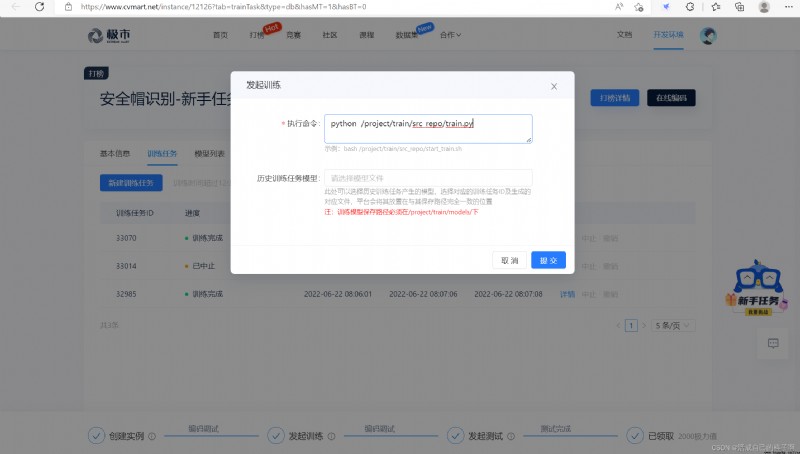
沒錯!!!以上命令和我們平時右鍵運行【pycharm】是一樣的效果哒~
一開始的訓練日志: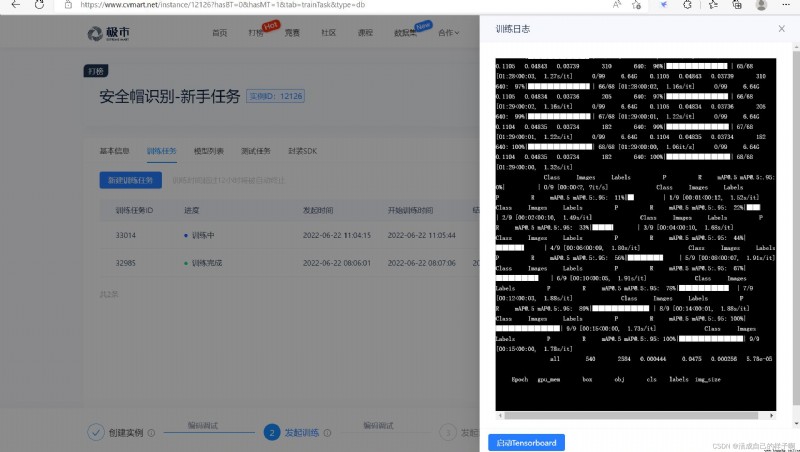
過了40輪之後的訓練日志:
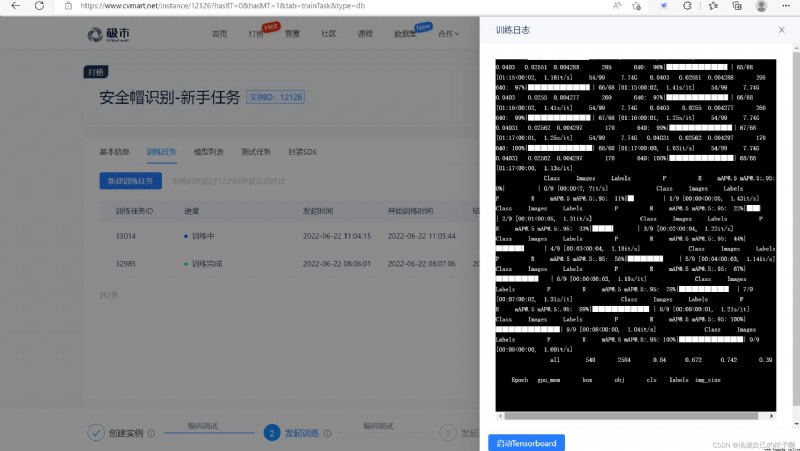
可以看到指標發生了明顯的提升!
當然,因為我修改了yolov5 project的保存路徑,所以你也可以看到tensorboard效果圖!

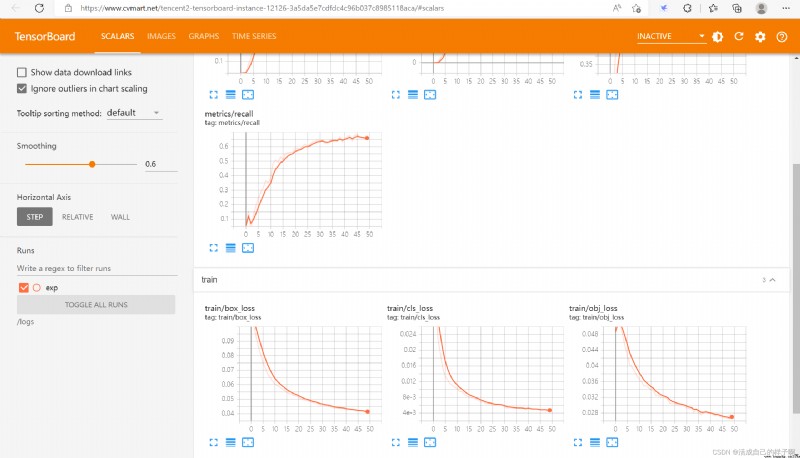
注:這裡可以看見我只訓練了50輪。但是模型還沒有收斂。
這一步是最後一步,也是最關鍵的一步,不是最難的,但是最費事的。。。
可以看到:(我經過了無數次的失敗測試,才成功提交上了!唔)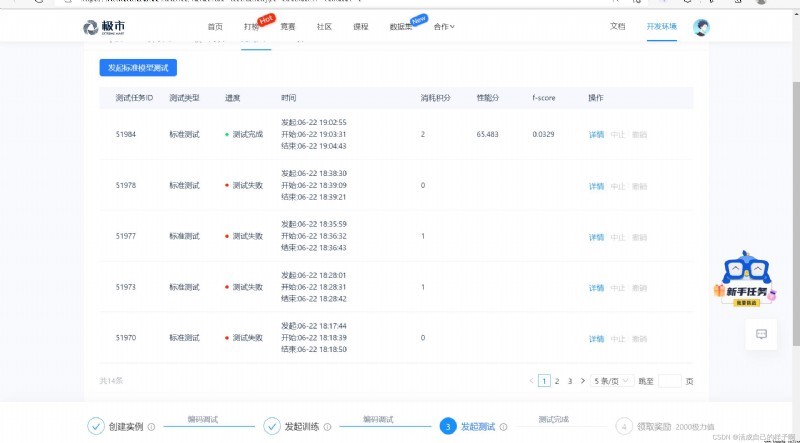
極市測試是直接調用 /project/ev_sdk/src 下的 ji.py 文件(名字別弄錯了),所以我們需要自己寫一個接口在該路徑下面!!!
我直接給出代碼:
/project/ev_sdk/src/ji.py :(注意這裡的導包!!用的是相對路徑導包,沒辦法,極市非得用這個位置測試,我又懶得移動文件)
注:那個model_path變量賦值成自己的權重保存路徑。。。別直接抄上了。。。
import json
import torch
import sys
import numpy as np
import cv2
from pathlib import Path
#from ensemble_boxes import weighted_boxes_fusion
# from train.src_repo.models.experimental import attempt_load
# from train.src_repo.utils.torch_utils import select_device
# from train.src_repo.utils.general import check_img_size, non_max_suppression, scale_coords
from train.src_repo.utils.augmentations import letterbox
from train.src_repo.models.common import DetectMultiBackend
from train.src_repo.utils.dataloaders import IMG_FORMATS, VID_FORMATS, LoadImages, LoadStreams
from train.src_repo.utils.general import (LOGGER, check_file, check_img_size, check_imshow, check_requirements, colorstr, cv2,
increment_path, non_max_suppression, print_args, scale_coords, strip_optimizer, xyxy2xywh)
from train.src_repo.utils.plots import Annotator, colors, save_one_box
from train.src_repo.utils.torch_utils import select_device, time_sync
device = torch.device("cuda:0")
model_path = r'/project/train/models/epoch48.pt' # 模型地址一定要和測試階段選擇的模型地址一致!!!
@torch.no_grad()
def init():
weights = model_path
device = 'cuda:0' # cuda device, i.e. 0 or 0,1,2,3 or
half = True # use FP16 half-precision inference
device = select_device(device)
w = str(weights[0] if isinstance(weights, list) else weights)
# model = torch.jit.load(w) if 'torchscript' in w else attempt_load(weights, map_location=device)
model = DetectMultiBackend(w, device=device, dnn=False, data=r'/project/train/src_repo/voc-myself.yaml', fp16=True)
if half:
model.half() # to FP16
model.eval()
return model
def process_image(handle=None, input_image=None, args=None, **kwargs):
half = True # use FP16 half-precision inference
conf_thres = 0.3 # confidence threshold
iou_thres = 0.05 # NMS IOU threshold
max_det = 1000 # maximum detections per image
imgsz = [640, 640]
names = {
0: 'person',
1: 'hat',
2: 'head'
}
stride = 32
fake_result = {}
fake_result["model_data"] = {"objects": []}
img = letterbox(input_image, imgsz, stride, True)[0]
img = img.transpose((2, 0, 1))[::-1] # HWC to CHW, BGR to RGB
img = img/255 # 0 - 255 to 0.0 - 1.0
img = torch.from_numpy(img)
img = torch.unsqueeze(img, dim=0).to(device)
img = img.type(torch.cuda.HalfTensor)
pred = handle(img, augment=False, visualize=False)
pred = non_max_suppression(pred, conf_thres, iou_thres, None, False, max_det=max_det)
for i, det in enumerate(pred): # per image
det[:, :4] = scale_coords(img.shape[2:], det[:, :4], input_image.shape).round()
for *xyxy, conf, cls in reversed(det):
xyxy_list = torch.tensor(xyxy).view(1, 4).view(-1).tolist()
conf_list = conf.tolist()
label = names[int(cls)]
fake_result['model_data']['objects'].append({
"xmin": int(xyxy_list[0]),
"ymin": int(xyxy_list[1]),
"xmax": int(xyxy_list[2]),
"ymax": int(xyxy_list[3]),
"confidence": conf_list,
"name": label
})
return json.dumps(fake_result, indent=4)你以為這樣就完了嗎?no way!
因為相對位置的原因,你需要把yolov5代碼裡面所有的導包給改掉,改成相對路徑導包!!!
例如:加上 train.src_repo.
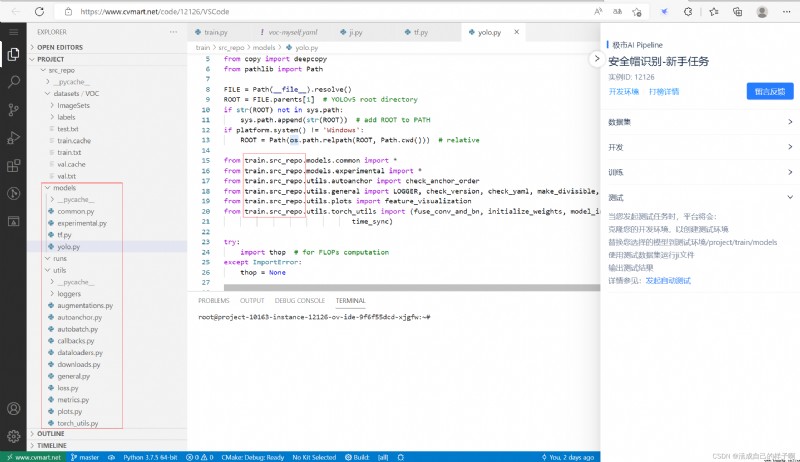
左邊畫紅圈的文件都需要改!!!
提示:
直接debug(F5)ji.py 文件,看他報錯就行,知道不報導包的錯誤了,就說明全部改完了。
【這裡如果有大神有好的辦法也可以拿出來分享哦!!!】
emmm,最後別忘了領取獎勵哦!
